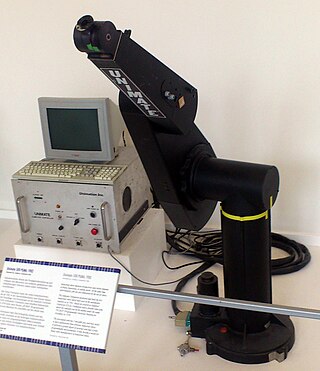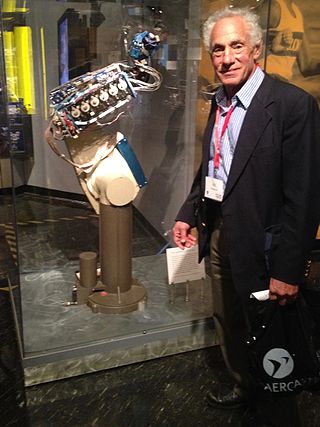

Unimate was the first industrial robot, [1] which worked on a General Motors assembly line at the Inland Fisher Guide Plant in Ewing Township, New Jersey, in 1961. [2] [3] [4]


Unimate was the first industrial robot, [1] which worked on a General Motors assembly line at the Inland Fisher Guide Plant in Ewing Township, New Jersey, in 1961. [2] [3] [4]
It was invented by George Devol in the 1950s using his original patent filed in 1954 and granted in 1961 [5] ( U.S. patent 2,988,237 ). The patent begins:
The present invention relates to the automatic operation of machinery, particularly the handling apparatus, and to automatic control apparatus suited for such machinery. [6]
Devol, together with Joseph Engelberger, his business associate, started the world's first robot manufacturing company, Unimation. [7]
The machine weighed 4000 pounds [8] and undertook the job of transporting die castings from an assembly line and welding these parts on auto bodies, a dangerous task for workers, who might be poisoned by toxic fumes or lose a limb if they were not careful. [4]
The original Unimate consisted of a large computer-like box, joined to another box and was connected to an arm, with systematic tasks stored in a drum memory.
In 2003 the Unimate was inducted into the Robot Hall of Fame. [9]
The Unimate appeared on The Tonight Show hosted by Johnny Carson on which it knocked a golf ball into a cup, poured a beer, waved the orchestra conductor's baton and grasped an accordion and waved it around. [7] [10]
Fictional robots called Unimate, designed by the character Alan von Neumann, Jr., appeared in comic books from DC Comics. [11]

A robot is a machine—especially one programmable by a computer—capable of carrying out a complex series of actions automatically. A robot can be guided by an external control device, or the control may be embedded within. Robots may be constructed to evoke human form, but most robots are task-performing machines, designed with an emphasis on stark functionality, rather than expressive aesthetics.

An industrial robot is a robot system used for manufacturing. Industrial robots are automated, programmable and capable of movement on three or more axes.

Automation describes a wide range of technologies that reduce human intervention in processes, mainly by predetermining decision criteria, subprocess relationships, and related actions, as well as embodying those predeterminations in machines. Automation has been achieved by various means including mechanical, hydraulic, pneumatic, electrical, electronic devices, and computers, usually in combination. Complicated systems, such as modern factories, airplanes, and ships typically use combinations of all of these techniques. The benefit of automation includes labor savings, reducing waste, savings in electricity costs, savings in material costs, and improvements to quality, accuracy, and precision.

The PUMA is an industrial robotic arm developed by Victor Scheinman at pioneering robot company Unimation. Initially developed by Unimation for General Motors, the PUMA was based on earlier designs Scheinman invented while at Stanford University based on sponsorship and mentoring from robot inventor George Devol.

The Friden Flexowriter produced by the Friden Calculating Machine Company, was a teleprinter, a heavy-duty electric typewriter capable of being driven not only by a human typing, but also automatically by several methods, including direct attachment to a computer and by use of paper tape.

Automatix Inc., founded in January 1980, was the first company to market industrial robots with built-in machine vision. Its founders were Victor Scheinman, inventor of the Stanford arm; Phillippe Villers, Michael Cronin, and Arnold Reinhold of Computervision; Jake Dias and Dan Nigro of Data General; Gordon VanderBrug, of NBS, Donald L. Pieper of General Electric and Norman Wittels of Clark University.

George Charles Devol Jr. was an American inventor, best known for creating Unimate, the first industrial robot. Devol's invention earned him the title "Grandfather of Robotics". The National Inventors Hall of Fame says, "Devol's patent for the first digitally operated programmable robotic arm represents the foundation of the modern robotics industry."

Joseph Frederick Engelberger was an American physicist, engineer and entrepreneur. Licensing the original patent awarded to inventor George Devol, Engelberger developed the first industrial robot in the United States, the Unimate, in the 1950s. Later, he worked as entrepreneur and vocal advocate of robotic technology beyond the manufacturing plant in a variety of fields, including service industries, health care, and space exploration.

Victor David Scheinman was an American pioneer in the field of robotics. He was born in Augusta, Georgia, where his father Léonard was stationed with the US Army. At the end of the war, the family moved to Brooklyn and his father returned to work as a professor of psychiatry. His mother taught at a Hebrew school.

Unimation was the world's first robotics company. It was founded in 1962 by Joseph F. Engelberger and George Devol and was located in Danbury, Connecticut. Devol had already applied for a patent an industrial robotic arm in 1954; U.S. Patent 2,988,237 was issued in 1961.
Robot software is the set of coded commands or instructions that tell a mechanical device and electronic system, known together as a robot, what tasks to perform. Robot software is used to perform autonomous tasks. Many software systems and frameworks have been proposed to make programming robots easier.
The following outline is provided as an overview of and topical guide to automation:

Industrial paint robots have been used for decades in automotive paint applications.

A mechanical arm is a machine that mimics the action of a human arm. Mechanical arms are composed of multiple beams connected by hinges powered by actuators. One end of the arm is attached to a firm base while the other has a tool. They can be controlled by humans either directly or over a distance. A computer-controlled mechanical arm is called a robotic arm. However, a robotic arm is just one of many types of different mechanical arms.

The history of robots has its origins in the ancient world. During the industrial revolution, humans developed the structural engineering capability to control electricity so that machines could be powered with small motors. In the early 20th century, the notion of a humanoid machine was developed.

Robots of the United States include simple household robots such as Roomba to sophisticated autonomous aircraft such as the MQ-9 Reaper that cost 18 million dollars per unit. The first industrial robot, robot company, and exoskeletons as well as the first dynamically balancing, organic, and nanoscale robots originate from the United States.
The Inland Fisher Guide Plant was a General Motors facility located in the West Trenton section of Ewing Township, New Jersey, that opened in 1938 as one of its most modern plants and was operated by the firm for 60 years. The facility was initially part of the Ternstedt division of GM's Fisher Body unit and was used to construct auto parts such as body moldings, door handles and other interior components. During World War II, the facility was converted to build torpedo bombers for the United States Navy as part of GM's Eastern Aircraft.

A cobot, or collaborative robot, is a robot intended for direct human-robot interaction within a shared space, or where humans and robots are in close proximity. Cobot applications contrast with traditional industrial robot applications in which robots are isolated from human contact or the humans are protected by robotic tech vests. Cobot safety may rely on lightweight construction materials, rounded edges, and inherent limitation of speed and force, or on sensors and software that ensure safe behavior.

Packaging machinery is used throughout all packaging operations, involving primary packages to distribution packs. This includes many packaging processes: fabrication, cleaning, filling, sealing, combining, labeling, overwrapping, palletizing.
Mobile industrial robots are pieces of machinery that are able to be programmed to perform tasks in an industrial setting. Typically these have been used in stationary and workbench applications; however, mobile industrial robots introduce a new method for lean manufacturing. With advances in controls and robotics, current technology has been improved allowing for mobile tasks such as product delivery. This additional flexibility in manufacturing can save a company time and money during the manufacturing process, and therefore results in a cheaper end product.